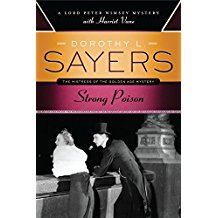Blog Archives
“You Want Me To Explain?”
“You want me to explain?”
So begins Chapter 22 of Peril at End House, Agatha Christie’s 1931 mystery. The suspects are gathered at End House, frightened and baffled all. Hercule Poirot, master detective and proprietor of the most efficient little gray cells on the planet, proffers a complete explanation of the mystery, pulls one final ace from his sleeve, and Inspector Japp pounces upon the murderer.
I’m thinking about endings at the moment, because I’ve just read Love Lies Bleeding by Edmund Crispin, originally published in 1948 and recently revived in e-book form. Happily nestled in a cozy setting (a mildly parodic English public school), the reader encounters a murder scene fairly littered with incomprehensible clues, a rather affected amateur detective – Oxford don Gervase Fen, who drives a very fast car – intrepid schoolgirls and a long-lost Shakespeare manuscript.
Unhappily – it made me unhappy, anyway – Fen refuses to discuss his observations or deductions except to suggest that the police and presumably the reader should have made them already. It’s description, dialogue and car chases all the way down.
At least, it is until the 85% mark on my handy smartphone e-reader. At that point, the unrecognizable body of the villain has been hauled from his wrecked car, detective and headmaster are back at the school, and Fen proceeds to explain exactly what we should have noticed and deduced. He does this for a very long time.
That last 15% was where, as a writer, I learned something. I could see Crispin’s method of creating his book as clearly as if he had personally explained it to me. Fen lays out the course of events, everyone’s actions, motives and even thoughts. Here and there, alternative explanations that might occur to the reader are explained away or dismissed as unnecessary to the main line of deduction. I’m morally certain that Crispin has simply placed his original outline, complete with his second thoughts and his solutions to them, in his detective’s mouth.
Once he had the outline, Crispin (IMHO) plucked out his list of clues, clothed them in pieces of necessary action that made striking scenes and trotted Fen through them. The occasional ‘but surely you have already realized…?’ reminds us that Fen is solving the crime – entirely out of the reader’s sight.
It didn’t make a satisfactory mystery novel. That is what sent me to Agatha Christie, who regularly wound up her books with concluding explanations by the detective. They are shorter than Crispin’s (and crisper), though Poirot does break the Detective Club rule that the reader must have all the clues in his hand before the revelation.
So, by way of contrast, let us consider the ideal, the perfection of the form: the solution of the murder of Philip Boyes, lover of the accused murderer, Harriet Vane, in Dorothy L. Sayers’ Strong Poison.
As the book opens, Harriet’s trial has ended in a hung jury. Lord Peter, suddenly in love, has only 30 days to find the real murderer before her retrial. For the first two-thirds of the book, we follow him down blind alleys and through unproductive interviews, unearthing suspects and clues aplenty in vivid, entertaining venues, but no proof. The last of these chapters ends with the collapse of the most promising theory.
Then, in a refreshing change of scene and pace, informants whom Lord Peter has planted among the suspects reward his foresight. Miss Katharine Alexandra Climpson – surely Sayers’ most delightful secondary character – unearths the motive. Miss Murchison, who has infiltrated the murderer’s office, finds the means. And rather than instantly deducing the opportunity from these facts, Lord Peter spends a sleepless night struggling to imagine how the crime was committed.
Sayers does withhold his reasoning on this one point from the reader, but only for a few pages. For the rabid mystery fan, she even drops three hints: Lord Peter found the answer after consulting these books: “The Trial of Florence Maybrick; Dixon Mann’s Forensic Medicine and Toxicology; … and A.E. Housman’s A Shropshire Lad.” The clues are in the reader’s hands. Using them, Lord Peter proceeds to trap the villain.
So. I think I can see how Crispin produced a passable mystery. It sounds like an exercise worth doing as a start. Now all I need is the wit and the stamina to take the result of that exercise and turn it into the next Strong Poison.
****
To end on a happy note for less-than-Sayers-level writers: Love Lies Bleeding is a “best seller” on Amazon – in the category of “Kindle kidnapping crime fiction” By some measurement or other, fame awaits us all.


